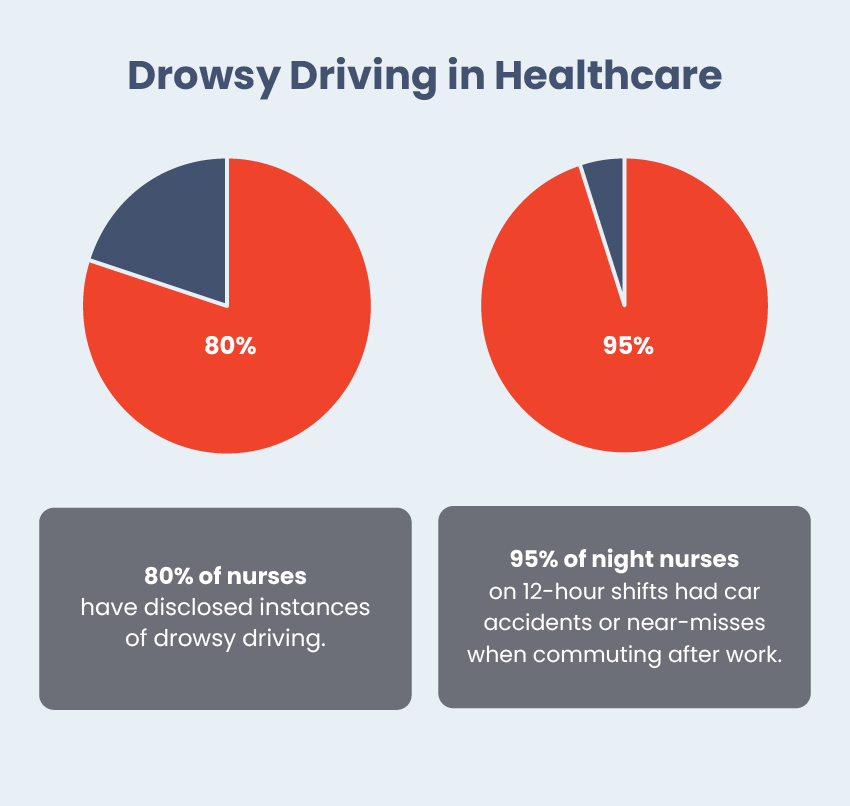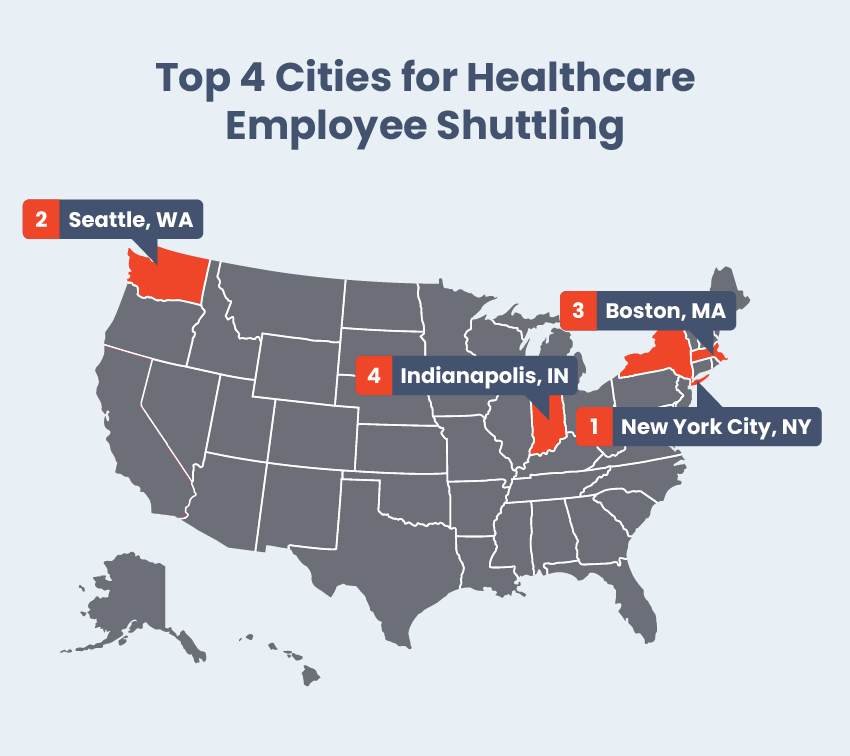The Benefits of Shuttles for Healthcare Workers
In many ways, healthcare remains a primarily in-person industry, where a human touch and immediate response are paramount. In fact, a Gallup study revealed that only 35% of white-collar healthcare workers had the opportunity to work remotely, showcasing the sector’s undeniable need for on-site presence.
However, this steadfast commitment to a physical presence comes with its own set of challenges—and chief among them is the daily commute. For healthcare workers, concerns about safety, reliability, and overall well-being are not just abstract concepts, but tangible, everyday realities.
In this post, we’ll explore how implementing healthcare shuttle buses can benefit the healthcare industry and give peace of mind to the professionals who tirelessly serve our communities.
Table of Contents:
- Commuting Challenges for Healthcare Workers
- Employee Shuttle Programs: A Solution for Healthcare Workers
- Best Cities for Healthcare Employee Shuttling
- Implement Healthcare Employee Shuttles With GOGO Charters
Commuting Challenges for Healthcare Workers
Healthcare professionals face a unique set of challenges when it comes to their daily commute, often compounded by the demanding nature of their work. Long hours, erratic shifts, and the high-pressure environments they work in contribute to fatigue, magnifying the physical and emotional toll of their journey to and from work.
Increased Risk of Drowsy Driving
In the fast-paced healthcare environment, irregular schedules and extended work hours are the norm, disrupting workers’ circadian rhythms and making it challenging to obtain restorative rest. This perpetual state of sleep deprivation significantly heightens the risk of drowsy driving during their commute to and from work.
Research conducted by the International Archives of Occupational and Environmental Health revealed a concerning trend: 80% of nurses have disclosed instances of drowsy driving, with some encountering this issue on a daily basis.
The study also found that among the 31% of healthcare professionals who reported being involved in at least one motor vehicle accident, over 56% admitted to having experienced drowsy driving on at least one occasion. Most accidents and incidents related to drowsy driving occurred during the commute to and from their residences.
Another study from the National Highway Traffic Safety Administration found that approximately 95% of night nurses working 12-hour shifts reported having an automobile accident or near-miss accident while driving home from work.

Sleep deprivation impairs cognitive function, attention, and reaction times—components crucial for safe driving. The combination of reduced alertness and the need to navigate busy roadways can create a dangerous recipe for potential accidents. Healthcare workers may unintentionally put themselves and others at risk in these situations.
Public Transportation Safety Concerns
Healthcare roles often translate into late-night or early-morning commutes due to the round-the-clock nature of the profession. However, these off-peak hours can raise safety concerns for those who use public transportation.
Late-night commutes, often involving reduced passenger volumes and limited lighting at stops, can create an environment where healthcare workers may feel vulnerable. Public transport systems, which typically cater to a diverse range of passengers, might not always provide the sense of security employees need during their unconventional travel times.
This concern is especially prevalent among women, who are 10% more likely to feel unsafe on public transit than men. Considering over 77% of healthcare employees are female, these safety concerns become even more pressing.

Data from the Bureau of Transportation Statistics underscores these worries, revealing a concerning uptick in incidents on public transit in 2021. There was a notable 38% increase in assaults in the last five years. This concerning trend highlights a critical safety issue faced by healthcare workers who rely on public transit, especially during off-peak hours.
Public Transportation Reliability
In the demanding profession of healthcare, time is of the essence. Healthcare workers are expected to deliver timely and often life-saving care to their patients. However, when they rely on public transportation, the potential for delays and longer commute times can pose significant challenges to their ability to begin their shift on time.
Public transportation, while an essential service, can be susceptible to potential delays and longer transit times. For example, the U.S. Census Bureau revealed that the average one-way commute time for employees riding public buses was over 46 minutes. This is due in part to the many stops these buses must make.
For healthcare workers, these delays can translate into late arrivals and sometimes even missed shifts. The consequences of these disruptions extend beyond personal inconveniences; they can directly impact patient care, causing delays in treatments and affecting the overall quality of healthcare delivery.
Employee Shuttle Programs: A Solution for Healthcare Workers
Given the importance of healthcare professionals’ safety and well-being, implementing employee shuttles may be the solution.
Though employee shuttles offer advantages across multiple sectors, they’re particularly noticeable within the healthcare industry, given the distinct nature of commutes.
Address Safety Concerns for Healthcare Professionals
Safety is a huge priority for healthcare professionals, particularly during late-night or early-morning commutes. Employee shuttle services can address these safety concerns by allowing workers to travel alongside their trusted colleagues, rather than strangers on public transportation.
Additionally, employee shuttles play a significant role in minimizing the risk of drowsy driving. These shuttles allow healthcare employees to rest during their journey, effectively reducing the likelihood of drowsy driving accidents. As a result, employees arrive at their workplace feeling better rested, promoting safer road conditions and ultimately enhancing the quality of patient care.
Boost Retention and Job Satisfaction
Healthcare is a demanding industry, so providing employees with benefits to help boost their satisfaction is critical. Employee shuttles can alleviate the stress associated with commuting, providing a reliable and comfortable mode of transportation and leading to less fatigue and frustration.
It can also foster camaraderie amongst healthcare teams. The social aspect of the commute can lead to stronger professional relationships and a sense of belonging within the workplace, both of which are essential for job satisfaction.
Additionally, employee shuttle programs can be tailored to the unique needs of healthcare workers, including accommodating shift changes and providing specialized amenities like reclining seats for some extra shut-eye. This customization demonstrates employers’ commitment to the well-being of their staff, enhancing job satisfaction.
Improve the Healthcare Workforce Shortage
There’s currently a severe shortage of workers in the U.S. healthcare industry. In fact, studies predict that by 2026, over 6.5 million healthcare professionals will permanently leave their roles, while only 1.9 million new recruits will enter the field. This alarming trend leaves a shortage of more than 4 million workers within the national healthcare sector.

One of the main reasons behind this is burnout, which is caused by long hours and a high-stress work environment. Unfortunately, with so many people leaving the industry, this causes even more burnout for the employees left to fill in the gaps.
Introducing employee shuttle programs presents a viable solution to alleviate commuting stress. Offering a commuting solution also opens up your potential labor force beyond those with a car or the ability to use public transportation. This inclusivity also significantly enhances an organization’s ESG rating, emphasizing its commitment to social responsibility.
Kece Ward, an HR specialist from Human Resource, shares her insights into implementing employee shuttles:
“Employee shuttles have proven to be a good solution to employee dissatisfaction and, ultimately, turnover. We’ve noticed that employees have been less stressed and healthier overall. In turn, their productivity has increased, as has our retention. To be precise, our employee turnover rates have declined by 30% since the introduction of employee shuttles.”
Best Cities for Healthcare Employee Shuttling
The suitability of cities for healthcare employee shuttling depends on various factors, including the size of the healthcare workforce, traffic congestion, public transportation infrastructure, and number of healthcare facilities. Considering these factors, here are four U.S. cities well-suited for healthcare employee shuttle programs.

New York City
With a large healthcare workforce of about 750,000 and extensive public transportation options, New York City is an ideal location for employee shuttling in the healthcare sector. The city has extensive public transportation, but comes at the price of a taxing 51.2-minute commute for healthcare workers.
By utilizing employee shuttles, healthcare professionals can bypass the need for public transit, eliminating the additional time consumed by multiple stops and transfers during their commute.
Seattle
Seattle, Washington’s healthcare sector is on the rise, with projections indicating more than 10,000 new healthcare positions over the next decade. The city is also dedicated to sustainability, actively working to reduce vehicular congestion. Introducing employee shuttle services tailored to healthcare jobs offers a promising avenue to achieve these goals by curbing the number of vehicles on the road while simultaneously enhancing the overall commuting experience for healthcare professionals.
Boston
Home to renowned medical institutions like Massachusetts General Hospital and Harvard Medical School, Boston, Massachusetts has a thriving healthcare sector. Boston is also the third top city in the U.S. with the most healthcare workers per capita.
However, the city grapples with substantial traffic congestion, logging a staggering 149 annual hours of gridlock. Implementing employee shuttle services is a viable solution to ease transportation challenges for healthcare professionals and elevate their accessibility to medical facilities.
Indianapolis
Indianapolis, Indiana, boasts the fourth-highest number of healthcare workers per capita, totaling 101,500 professionals. However, the region’s expansive geography, spanning just over 35,826 square miles, can result in commutes of over 30 minutes under optimal traffic conditions and at least an hour during rush hours when traveling between the city and suburbs.
As revealed in this study, public transportation in Indianapolis ranks at the bottom among 100 cities, with less than 2% of residents utilizing it, likely due to issues related to inconvenience and quality. Employee shuttles offer a compelling alternative for healthcare workers, allowing them to bypass lengthy drives and opt for a more convenient commuting option.
Implement Healthcare Employee Shuttles With GOGO Charters
From reducing the risks of drowsy driving and mitigating concerns related to public transportation to improving job satisfaction and retention, healthcare shuttles provide a dependable and convenient solution. However, implementing such services can be daunting for hospitals already managing numerous tasks.
GOGO Charters’ healthcare shuttle program offers these benefits without overwhelming logistical burdens. With our expertise and resources, businesses can focus on core operations while we handle transportation logistics.
Contact our reservation team at 1-855-826-6770 to learn more or book the ideal charter or minibus for your healthcare shuttle needs.
Recent Posts
- Your Charter Bus Packing and Carry-On Guide
- Average Vacation Costs in 2024: Transportation, Entertainment, and Budgeting Tips
- 20 Best Multigenerational Travel Destinations in the U.S.
- 88 Must-Know Travel Statistics by Age Group for 2024
- Top 25 Affordable Warm Weather Destinations in the U.S. for Winter Travel
- 15 Best Corporate Retreat Locations in California
- The Benefits of Shuttles for Healthcare Workers
- Top 30 Offsite Locations for Large Groups in Washington, D.C.
Do you need to rent a charter bus?
Do you need a long-term shuttle service?
We offer contracted shuttle services for businesses, schools, hotels, and more. Contact our experts at 1-844-897-5201 to discuss your long-term transportation plans.
Overall Rating: 10 out of 10 from 422 unique reviews

